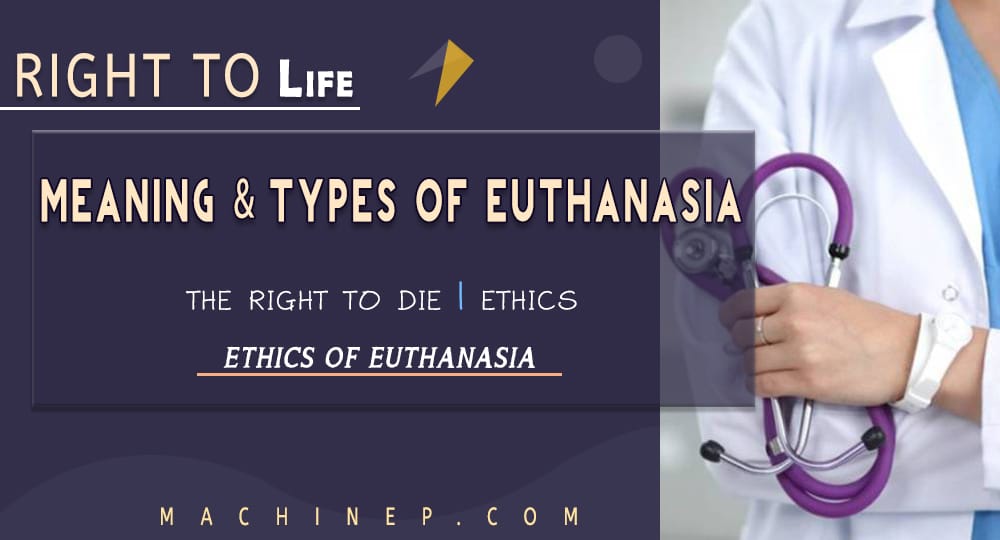The Ethics of Euthanasia
Preamble
The term euthanasia as a debatable issue was first debated, to be legalized in the united kingdom by a body known as, The voluntary Euthanasia Society, founded in 1935 which bill never held a once of water in the House of Lords in the UK. This debate cuts across complex and dynamic aspects, such as philosophical, legal, ethical, religious, and political, aspects of the civilized society.
Discussions on this issue are complicated further by misunderstanding and confusion, of the terminology. Hence, I am propelled to consider the clarification of the meaning of euthanasia, types, religious and legal implications. It is therefore hoped that religious and legal implications.
It is therefore hoped that this write-up will meet the approval of many people of goodwill, whose philosophical or ideological difference notwithstanding our changed generation, have nevertheless lively awareness of the rights of the human person.
Meaning of Euthanasia
Euthanasia is broadly defined as a deliberate action to ends someone’s life usually to relieve suffering. Medical practitioners sometimes carry out Euthanasia at the request of patients who are in critical pain due to terminal illness.
However, due to the complexity in the process of performing Euthanasia, there are many factors to be considered. These factors range from the patient’s mental health, personal beliefs, related laws, and a lot more.
Types of Euthanasia
There are several types of Euthanasia namely:
- Assisted Suicide
- Active and Passive Euthanasia
- Voluntary and Non-voluntary Euthanasia
1. Assisted Suicide
Assisted Suicide is the deliberate act of assisting someone to commit suicide. It is otherwise called physician-assisted suicide (PAS). This entails that the doctor or physician is knowingly helping someone to end his/her life. Assisted suicide is usually performed when the patient suffers terribly from unending pains upon a terminally ill diagnosis. Their doctor will determine the most effective, painless approach.
In most cases, Assisted suicide is done by providing drugs to a patient to take and end his life. A good example of those drugs is a lethal dose of opioids.
But, Euthanasia gives the doctor the right to end the person’s life by painless means. For example, an injection of a lethal drug may be used.
2. Active vs. Passive Euthanasia
Active Euthanasia is the direct act of ending someone’s life by the doctor. Active Euthanasia could be performed by giving someone a lethal dose of sedative to take. The person takes the drugs and dies gradually in less pain.
However, passive Euthanasia is the indirect action of the doctor to help someone to end his life by not doing what he is supposed to do (such as not giving the person drugs as at when due) or by doing what he is supposed not to do (such as withholding or limiting life-sustaining treatments) with the intention of helping the person to end his/her life.
This makes the distinction between passive euthanasia and palliative care blurry. Palliative care focuses on keeping people as comfortable as possible at the end of their life.
For example, a palliative care doctor might allow someone approaching death to stop taking a medication that causes unpleasant side effects. In other cases, they might allow someone to take a much higher dose of pain medication to treat severe pain. This is often a standard part of good palliative care.
3. Voluntary vs. Non-voluntary Euthanasia
If someone makes a conscious decision to seek help with ending their life, it’s considered voluntary euthanasia. The person must give their full consent and demonstrate that they fully understand what will happen.
Nonvoluntary euthanasia involves someone else making the decision to end someone’s life. A close family member usually makes the decision. This is generally done when someone is completely unconscious or permanently incapacitated. It usually involves passive euthanasia, such as withdrawing life support from someone who’s showing no signs of brain activity.
The Value of Human Life
In the study of Philosophy, one of the courses to encounter is “Religion and Human Values“. In which every student is driven through the understanding of the meaning of values, the different things people value both the positive and negative ones, and also their hierarchy. Human life of all these values ranks first in that hierarchy because it is the basis of all goods, the necessary source, and condition precedence of every human, activity.
Most people regard life as something sacred and hold that no one may dispose of it at will. Some, like believes even see in life something greater, namely; a gift of God’s love which they are called upon to preserve and make fruitful. Hence, the injunction, increases, be fruitful and fill the earth. And this consideration has given rise to the following consequences:
- No one can make an attempt on the life of an innocent person without opposing God’s love for that person, without violating a fundamental right, and therefore without committing, a crime of the utmost gravity.
- Intentionally causing one’s own death, or suicide is, therefore, equally as wrong as murder; such an action on the part of a person is to be considered as a rejection of God’s sovereignty and loving plan. Which explains why
Under the typical African setting, one who kills another is either killed or banished forever. And those who commit suicide are equally punished through denial of profane burial rites or by disposing the corps into the evil forest. Because by committing suicide, the deceased is seen to have breached that duty saddled on him by the other of creation, i.e. the duty of justice and charity owed to a neighbor and the community at large.
However for proper clarification, one must distinguish suicide from that sacrifice of one’s life whereby for a higher course, such as God’s glory, the salvation, of soul’s or the service of one’s brethren, a person offers his or her own life or put it in danger. (Jm. 15:14).
The Ethics of Euthanasia
As a way of paraphrasing the theme of our discussion, one may ask “what is euthanasia all about?” Etymologically, euthanasia comes from the Greek words, ‘EU’ meaning ‘good’ and ‘Thanatos’ meaning death. Bringing both together, it succinctly means ‘the good death’. Before now, euthanasia was seen as an easy death without severe suffering.
Today, one no longer thinks of this original meaning of the word, but rather of some intervention of medicine whereby the suffering of sickness or of the final agony is reduced. Ultimately, the word euthanasia is used, in a more particular sense, to mean “mercy killing”, for the purpose, or putting an end to extreme suffering or saving abnormal babies, the mentally ill or the incurable sick from the prolongation, perhaps for many years of a miserable life, which could impose too heavy a burden on their families.
The Legal Implication of Euthanasia
As a result of the sacrosanct nature of life and how important it is, there has been over the time avalanche of pronouncements, both international and local which are geared towards safeguarding and preservation of life. Such pronouncements include the International Convention on Civil and Political Rights. African Character on Human and People’s Rights Universal Declaration on Human Rights 1948 etc.
The constitution of the Federal Republic of Nigeria 1999, in section 33(1) provides, that every person has a right to life, and no one shall be deprived intentionally of his life, save in execution of the sentence, of a count in respect of a criminal offence of which he has been found guilty in Nigeria.
However, there are exceptions allowed by the same law on which that life can be derogated. For example, in self-defense, the police in giving effect to a lawful arrest, suppressing or quelling a riot, insurrection or mutiny or giving effect to a death sentence. See. 3. 33(2) (a-c) of the 1999 constitution (supra).
It is still germane to note that, an exception has been developed, in some jurisdictions which makes the termination of the life of an incurable ill patient crime-free, provided:
- It was done by a guardian or immediate family member
- After due consultation with an ethics committee of a hospital
The Royal Dutch Medical Association in 1934, stated that “Euthanasia should remain a crime”, but that physicians performing euthanasia and assisted suicide, would not be prosecuted if they met the following requirements; (1) The request by the patient must be voluntary, durable and persistent. (2) The patient was fully informed about the medical condition and the prognosis, and there was no other alternative treatment avoidable. (3) the patient had unbearable suffering, and (4) The physician had Consulted with another physician.
One challenge to the guideline for euthanasia and physician-assisted suicide in the Netherlands was the apparent ‘slippery slope’ phenomenon. This could be illustrated by the following cases.Dr. Chabot, a psychiatrist, who helped a physically fit patient with a history of depression for 20 years to commit suicide by prescribing a lethal drug in 1991. The Dutch supreme court found him guilty as changed only because he had never allowed another doctor to examine the patient.
In 1995, the District Court in Alkmaar discharged and acquitted Dr. Prins who gave a lethal injection to a baby girl born with a partly formed brain and spina bifida. Because he consulted her parents and other physicians. The right of the terminally ill act was passed by the Northern Territory parliament on 25 May 1995, which became law on 1st July 1996. Thus, making Australia the first country to pass laws allowing a physician to end the life of the terminally ill patient.
Hence, Mr. Bob Dent, a 66-year-old Darwin resident suffering from Carcinoma of the prostate, became the first person in the world to die under euthanasia legislation through the help of Dr. Philip Nietschker on 22nd September 1996. Followed by Mrs. Jenet Mills, a 52-year-old lady who suffered mycosis fungoides. But after 6 months of the first death under the act, that right was overturned by the Australian Federal Senate.
Death with Dignity
Advocates of Euthanasia often begin by talking about ta right to die, that euthanasia should be a matter of voluntary choice, the right to choose a dignified death instead of a degrading and disgusting twilight life. This is evidenced by the creation of several organizations in many parts of the world which espouse euthanasia as fundamental rights.
But dignity in old age and in pain is a matter of the spirit even more than of the body. As dying can be an opportunity – a man’s last opportunity –for showing courage, nobility, and serenity. A priest once wrote a book about dying: he called it “The Last Achievement”. One has a right to die one’s own death; but, for a Christian, his own death is that willed by God at the time and in the manner He wills. He went further to say that life itself is grace. The time of one’s life is a time of God’s love and grace. It is not for us to put limits on his grace or love.
Again, dignity in old age and pain helps to determine whether one is loved or not. No one who knows he is loved ever loses dignity. It is true that long illness and helplessness impose a great strain on the love of relatives. But euthanasia existed as a possibility, the strain on the love would become unbearable, both for the relatives and for the patients. The patient, relatives, and the doctor could never have complete trust in one another.
The patient might feel he was being selfish if he did not seek death in order to relieve relatives of the hopeless burden. He might feel unwanted and suspect that relatives were silently hoping he would ask for death. Both relatives and patients would be unsure of their doctor’s attitude or the purpose of his prescriptions. Those with experience of nursing the terminally ill and old know what the fear is not with so much as being abandoned and left alone.
The fear being unloved and unwanted even more than they fear pain. Everything is bearable, even death loses terror, in the presence of those who love us. Those with experience agree that a substantial component of all pain is psychological.
A Happy Death
Extract from moral questions of the statement of Bishop’s Conference of England and Wales, Dec 31, 1970. “it is trite that, the crown of a Christian life is a Christian, death. We have a traditional spirituality that looks forward to a “happy death”, by which we mean that we die at peace with God, fortified by the sacraments of the church. It is the part of a Christian to help others in their last hours and surround them with care. It is not the part of a Christian to terminate the life of another.
”The real answer to the euthanasian mentality is for Christians, to witness, both in personal conviction and in words, but above all by example, to the faith which gives us the joyful hope that “death is swallowed up in victory (1 Cor. 15:55). When Christians speak of a happy death, he is speaking of something much more than a death without pain. For him, death has a positive meaning as the door opening on a new life.
For Catholics, a might is a moral claim and we do not have a claim on death rather death has a claim on us. God is the only supreme who appoints the time of our birth and that of our death.
Conclusion
Having x-rayed the poignant challenges posed on our society by this quest for euthanasia, the paramount question remains whether it constitutes an infringement of the right of life when done with or without the consent of the subject. Having considered the constitutional guarantee of the right to life and the circumstances on which it could be restricted. It appears that euthanasia carried out with or without the consent of the subject is not within the permissible circumstances.
The answer to the problems currently facing us lies first and foremost in changing the attitude of the society and not in changing our laws. Euthanasia is society’s lazy way and unloming way of getting rid of the problem of pain and old age. I firmly believe that a positive approach to death by society in general, together with compassionate, competent medical care and considerate, patient-oriented nursing holds the answer to our present problem.
Finally, considering the unique position of relevance that the church occupies in the affairs of the society, it is not difficult, for the church to become the nucleus for coalescing the principle that would spearhead the realization of the true meaning of life and so come to preserve it at all cost.






Oh my goodness! an amazing article dude. Thanks